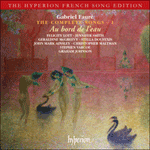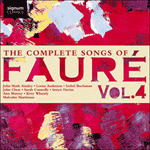Like
Les berceaux this is a poem that compares life at sea with life on dry land, or rather, in this case, death at sea with a decent Christian burial. Jean Richepin’s poem is taken from his bulky collection of often melodramatic verse entitled
La mer; the subsection is entitled
Les gas – ‘The chaps’, the sailors. The outer strophes are set in a cemetery. The initial peacefulness of this evocation precedes the savage contrast of music for victims of wave and storm. A mood of rarefied simplicity (the
Requiem is a contemporary work) depicts the poet’s thoughts on hallowed ground. The modal purity of these chordal progressions shines out with rare conviction. In Fauré’s songs, accompanying chords such as these often embark on complicated harmonic journeys; their rhythm is plain and undemonstrative, yet the effect, as here, is poignant and noble in its understatement. At the end of the poem’s fourth strophe a huge crescendo in the tonic key (in this case E minor, despite the misleading printing of the song a tone lower in Hamelle) plunges the mood into bitterness with amazing speed. All hell now breaks loose with a merciless chromatic tightening, a tidal wave of anguish in a dangerous tessitura. Left-hand triplets smash like breakers on to the second beats of the bar, the buffeting of a gigantic storm at sea. At the frightening image of ‘Et les yeux grands ouverts’ the accompaniment drifts like a body sinking to the depths. In a typically Fauréan ellipsis, as neat and almost as sudden as a change of shot in the cinema, we return to the safety of the churchyard and a recapitulation of the first verse. It is printed thus in Richepin’s poem, but Fauré, wishing to round out the musical shape in binary form, repeats the poet’s second strophe also.
from notes by Graham Johnson © 2005
Comme
Les berceaux, ce poème compare la vie en mer avec la vie sur la terre ferme, ou plutôt, en l’occurrence, la mort en mer avec une inhumation chrétienne décente. Ce texte est extrait de
La mer (volumineux recueil en vers, souvent mélodramatique, de Jean Richepin), et plus précisément d’une sous-section intitulée
Les gas – les marins. Les strophes extrêmes se déroulent dans un cimetière. La tranquillité première de cette évocation précède le contraste sauvage de la musique dédiée aux victimes des flots et des tempêtes. Une atmosphère de simplicité épurée (le
Requiem est contemporain) figure les considérations du poète sur la terre bénie, et la pureté modale de ces progressions en accords rayonne avec une rare conviction. Dans les mélodies fauréennes, ce genre d’accords accompagnants s’embarquent souvent dans des voyages harmoniques complexes; leur rythme est simple et peu démonstratif, pour un effet malgré tout poignant et noble dans sa minimisation, comme ici. À la fin de la quatrième strophe du poème, un immense crescendo à la tonique (dans le cas présent, mi mineur, malgré l’impression fallacieuse de la mélodie, un ton plus bas, dans la version de Hamelle) précipite l’ambiance dans l’amertume à une vitesse étonnante. Voilà que ça barde, maintenant, avec un impitoyable resserrement chromatique, un raz de marée d’angoisse dans une tessiture dangereuse. Des triolets à la main gauche se fracassent, tels des brisants, sur les deuxièmes temps de la mesure – l’assaut d’une gigantesque tempête en mer. À l’effrayante image de «Et les yeux grands ouverts», l’accompagnement dérive tel un corps sombrant dans les profondeurs. Puis, en une ellipse toute fauréenne, aussi précise et presque aussi soudaine qu’un changement de plan au cinéma, nous retrouvons la sécurité du cimetière et une reprise de la première strophe. Du moins en est-il ainsi dans le poème de Richepin, car Fauré, désireux de terminer la structure musicale en forme binaire, répète aussi la deuxième strophe du poète.
extrait des notes rédigées par Graham Johnson © 2005
Français: Hypérion


 Fauré: The Complete Songs, Vol. 1 - Au bord de l'eau
Fauré: The Complete Songs, Vol. 1 - Au bord de l'eau Fauré: The Complete Songs, Vol. 4
Fauré: The Complete Songs, Vol. 4
